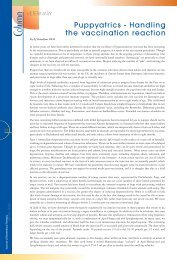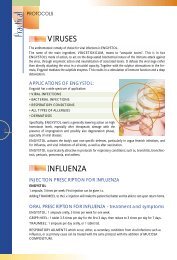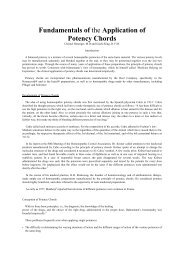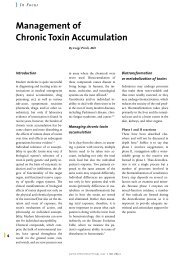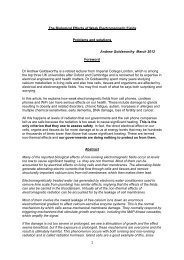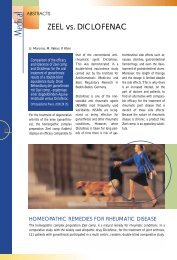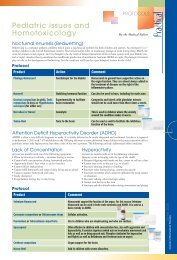Psychogenic Factors in Gastrointestinal Pathology - Bio Pathica Ltd
Psychogenic Factors in Gastrointestinal Pathology - Bio Pathica Ltd
Psychogenic Factors in Gastrointestinal Pathology - Bio Pathica Ltd
You also want an ePaper? Increase the reach of your titles
YUMPU automatically turns print PDFs into web optimized ePapers that Google loves.
) 18<br />
) Re f r e s h Yo u r H o m o t ox i c o l o g y<br />
<strong>Psychogenic</strong> <strong>Factors</strong> <strong>in</strong><br />
Gastro<strong>in</strong>test<strong>in</strong>al <strong>Pathology</strong><br />
Emotional triggers of immune<br />
disorders are very well-known<br />
<strong>in</strong> modern medic<strong>in</strong>e, especially<br />
where psycho-neuro-endocr<strong>in</strong>o-immunological<br />
(PNEI) effects are seen<br />
as a major trigger with<strong>in</strong> psychosomatic<br />
diseases. 1 Seroton<strong>in</strong>, adrenal<strong>in</strong>e,<br />
dopam<strong>in</strong>e, and glutamate are<br />
major neurotransmitters <strong>in</strong> the central<br />
nervous system. Seroton<strong>in</strong> and<br />
adrenal<strong>in</strong>e especially are secreted <strong>in</strong><br />
response to stress and emotion. All 4<br />
neurotransmitters mentioned are<br />
also present <strong>in</strong> a second, almost prehistorical,<br />
and often forgotten bra<strong>in</strong>,<br />
called the enteric bra<strong>in</strong>.<br />
This enteric nervous system, located<br />
<strong>in</strong> the gastro<strong>in</strong>test<strong>in</strong>al (GI) tract<br />
(more precisely <strong>in</strong> the epithelial l<strong>in</strong><strong>in</strong>g<br />
of the esophagus, stomach, and<br />
small and large <strong>in</strong>test<strong>in</strong>es), is a major<br />
subject <strong>in</strong> the study of neurogastroenterology<br />
and plays an important<br />
role <strong>in</strong> irritable bowel syndrome<br />
(IBS). Accord<strong>in</strong>g to some researchers,<br />
up to 95% of the seroton<strong>in</strong><br />
By Bruno Van Brandt<br />
Medical Education Manager of the IAH<br />
Is half a glass of water half full or half empty? Although the<br />
reality rema<strong>in</strong>s the same, the way <strong>in</strong>dividuals look at it will<br />
def<strong>in</strong>itely change their emotional state. Half full or half<br />
empty makes the difference between positivism and negativism,<br />
between stress and <strong>in</strong>ner peace, between psychogenic<br />
factors that will, over the ideomotorical rule <strong>in</strong> psychology,*<br />
enhance or <strong>in</strong>hibit physical condition or strength.<br />
available <strong>in</strong> the body is located <strong>in</strong><br />
the GI tract; of this 95%, 90% is <strong>in</strong><br />
the enterochromaff<strong>in</strong> cells, and the<br />
rema<strong>in</strong><strong>in</strong>g 10% can be found <strong>in</strong> enteric<br />
neurons. Seroton<strong>in</strong> plays a key<br />
role <strong>in</strong> the <strong>in</strong>itiation of peristaltic<br />
and secretory reflexes. 2<br />
Although the enteric bra<strong>in</strong> is described<br />
as part of the peripheral nervous<br />
system, it is also def<strong>in</strong>ed as the<br />
second bra<strong>in</strong>, 3 <strong>in</strong> addition to the primary<br />
central bra<strong>in</strong>. The central nervous<br />
system can <strong>in</strong>fluence the enteric<br />
bra<strong>in</strong> and vice versa. 3 This<br />
could be a possible explanation as to<br />
why an emotional stressor or anxiety<br />
can <strong>in</strong>directly <strong>in</strong>duce IBS.<br />
Dur<strong>in</strong>g stress, the bra<strong>in</strong> will <strong>in</strong>duce,<br />
over the bra<strong>in</strong>-gut axis, mast cell degranulation<br />
<strong>in</strong> the <strong>in</strong>test<strong>in</strong>al tract.<br />
By this degranulation, histam<strong>in</strong>e<br />
and phospholipids are set free <strong>in</strong><br />
large numbers, <strong>in</strong>duc<strong>in</strong>g <strong>in</strong>flammatory<br />
pathways. Activation of the gut<br />
immune system may disrupt normal<br />
gut motility, lead<strong>in</strong>g to common<br />
* Every thought or idea makes the body gravitate to fulfill that thought or idea. William James, The Pr<strong>in</strong>ciples of Psychology (1890)<br />
Journal of <strong>Bio</strong>medical Therapy 2009 ) Vol. 3, No. 1<br />
symptoms such as diarrhea, cramp<strong>in</strong>g,<br />
and bloat<strong>in</strong>g. 4<br />
The <strong>in</strong>flamed tissues render the enteric<br />
nerves overly sensitive and<br />
overactive, deregulat<strong>in</strong>g the production<br />
of seroton<strong>in</strong>. Both low and<br />
high levels of seroton<strong>in</strong> can cause<br />
problems. The same molecule, when<br />
available <strong>in</strong> a too low or a too high<br />
concentration, may <strong>in</strong>duce the same<br />
cl<strong>in</strong>ical symptom: cramps. As Paracelsus<br />
already stated centuries ago,<br />
“the dose makes the poison.”<br />
Low levels of seroton<strong>in</strong> are not only<br />
associated with depression, shortterm<br />
memory, and concentration<br />
deficits, but also, at the level of the<br />
enteric nervous system, with bowel<br />
problems such as constipation with<br />
spasm (IBS-C). Emotional stress,<br />
over the PNEI system, can thus <strong>in</strong>duce<br />
changes with<strong>in</strong> seroton<strong>in</strong> levels<br />
at the level of the GI tract and can<br />
<strong>in</strong>duce spasms (Figure 1). A stressrelated<br />
nervous or anxious state will<br />
<strong>in</strong>crease the prevalence or <strong>in</strong>tensity<br />
of <strong>in</strong>test<strong>in</strong>al spasm over the bra<strong>in</strong>gut<br />
axis. 5<br />
Increased levels of seroton<strong>in</strong> are associated<br />
with <strong>in</strong>test<strong>in</strong>al problems<br />
too, such as is seen <strong>in</strong> diarrhea<br />
accompanied by cramps (IBS-D). 6<br />
Selective seroton<strong>in</strong> reuptake <strong>in</strong>hibitor<br />
package <strong>in</strong>serts often mention<br />
both symptoms as possible adverse<br />
effects because of the medication<strong>in</strong>duced<br />
decreased reuptake of seroton<strong>in</strong><br />
and thus the <strong>in</strong>creased seroton<strong>in</strong><br />
availability and activity levels.
The conventional medical approach<br />
to IBS is often the use of antispasmodic<br />
agents, such as hyosc<strong>in</strong>e butylbromide,<br />
to relieve spasms and<br />
cramps. Research <strong>in</strong> conventional<br />
medic<strong>in</strong>e also reports the symptomreliev<strong>in</strong>g<br />
effects of benzodiazep<strong>in</strong>es<br />
<strong>in</strong> patients with IBS, 7,8 po<strong>in</strong>t<strong>in</strong>g at<br />
the psychogenic factors that <strong>in</strong>crease<br />
the physical symptoms over the<br />
bra<strong>in</strong>-gut axis. A comb<strong>in</strong>ation therapy<br />
of an antispasmodic medication<br />
with a benzodiazep<strong>in</strong>e seems to<br />
have synergic therapeutic effects <strong>in</strong><br />
the relief of IBS symptoms. 9 Treatments<br />
aimed at the gut-bra<strong>in</strong> <strong>in</strong>terface<br />
are <strong>in</strong> development, but have<br />
been difficult to establish because of<br />
adverse effects. 10<br />
<strong>Bio</strong>regulatory treatment<br />
It is thus <strong>in</strong>terest<strong>in</strong>g to look at a bioregulatory<br />
approach <strong>in</strong> these patients.<br />
In a comparative study, Nervoheel<br />
was found to be non<strong>in</strong>ferior<br />
to lorazepam, a benzodiazep<strong>in</strong>e prescribed<br />
worldwide, <strong>in</strong> the treatment<br />
of mild nervous disorders. 11 Spascupreel<br />
is a bioregulatory antispasmodic<br />
medication that will <strong>in</strong>duce<br />
symptomatic relief of spasmodic<br />
conditions of the <strong>in</strong>test<strong>in</strong>al tract. In<br />
a comparative study versus hyosc<strong>in</strong>e<br />
butylbromide, it was shown to possess<br />
a non<strong>in</strong>ferior therapeutic effect<br />
<strong>in</strong> treat<strong>in</strong>g <strong>in</strong>test<strong>in</strong>al cramps. 12 This<br />
effect of Spascupreel can be used <strong>in</strong><br />
conditions such as IBS, and, if it is<br />
applied together with a psychogenic<br />
) Re f r e s h Yo u r H o m o t ox i c o l o g y<br />
relax<strong>in</strong>g drug such as Nervoheel, a<br />
synergistic action on the gut-bra<strong>in</strong><br />
axis may be possible. In this way, a<br />
bioregulatory alternative can be offered<br />
for the comb<strong>in</strong>ation of antispasmodic<br />
agent–tranquilizer <strong>in</strong><br />
conventional therapy of IBS.<br />
Given the PNEI l<strong>in</strong>k between the<br />
central and enteric bra<strong>in</strong> and the experience<br />
<strong>in</strong> conventional medic<strong>in</strong>e<br />
(i.e., antispasmodic drugs <strong>in</strong> comb<strong>in</strong>ation<br />
with tranquillizers have a<br />
stronger symptom-reliev<strong>in</strong>g effect <strong>in</strong><br />
IBS), it can be stated that Nervoheel<br />
might play an important therapeutic<br />
role <strong>in</strong> the bioregulatory relief of<br />
IBS symptoms. Although some benzodiazep<strong>in</strong>es<br />
are known to be addictive,<br />
13 to my knowledge, no such<br />
risk has ever been reported for Nervoheel.<br />
Thus, Nervoheel is a safe alternative<br />
to benzodiazep<strong>in</strong>es. In the<br />
same way, Spascupreel is a safe and<br />
effective alternative to hyosc<strong>in</strong>e butylbromide<br />
<strong>in</strong> the symptomatic relief<br />
of patients with IBS. Known adverse<br />
effects of hyosc<strong>in</strong>e butylbromide <strong>in</strong>clude<br />
constipation, dry mouth, trouble<br />
ur<strong>in</strong>at<strong>in</strong>g, and nausea. Other adverse<br />
effects, which are very unlikely<br />
but reported, <strong>in</strong>clude rash, itch<strong>in</strong>g,<br />
swell<strong>in</strong>g of the hands or feet, trouble<br />
breath<strong>in</strong>g, <strong>in</strong>creased pulse, dizz<strong>in</strong>ess,<br />
diarrhea, vision problems, and<br />
eye pa<strong>in</strong>. To my knowledge, none of<br />
these adverse effects have ever been<br />
reported with Spascupreel.<br />
In conclusion, bioregulatory treatment<br />
may offer a viable alternative<br />
STRESS<br />
Intest<strong>in</strong>es<br />
Mood disturbances<br />
• Anxiety<br />
• Depression<br />
Central nervous system (bra<strong>in</strong>)<br />
Autonomic nervous system<br />
Enteric nervous system<br />
Smooth muscle<br />
Journal of <strong>Bio</strong>medical Therapy 2009 ) Vol. 3, No. 1<br />
<strong>in</strong> the management of conditions <strong>in</strong><br />
which the gut-bra<strong>in</strong> <strong>in</strong>terface causes<br />
deregulation of the enteric nervous<br />
system, the second bra<strong>in</strong>.|<br />
References:<br />
1. Sivik T, Byrne D, Lipsitt D, Christodoulou G,<br />
Dienstfrey H, eds. Psycho-Neuro-Endocr<strong>in</strong>o-<br />
Immunology (PNEI). Amsterdam, the Netherlands:<br />
Elsevier; 2002. Excerpta Medica<br />
International Congress Series 1241.<br />
2. Grider JR, Kuemmerle JF, J<strong>in</strong> JG. 5-HT released<br />
by mucosal stimuli <strong>in</strong>itiates peristalsis<br />
by activat<strong>in</strong>g 5-HT4/5-HT1p receptors<br />
on sensory CGRP neurons. Am J Physiol.<br />
1996;270(5 pt 1):G778-G782.<br />
3. Gershon MD. The enteric nervous system:<br />
a second bra<strong>in</strong>. Hosp Pract (M<strong>in</strong>neap).<br />
1999;34(7):31-32, 35-38, 41-42 passim.<br />
4. Törnblom H, L<strong>in</strong>dberg G, Nyberg B, Veress<br />
B. Full-thickness biopsy of the jejunum<br />
reveals <strong>in</strong>flammation and enteric neuropathy<br />
<strong>in</strong> irritable bowel syndrome. Gastroenterology.<br />
2002;123(6):1972-1979.<br />
5. Taché Y. Stress and irritable bowel syndrome:<br />
unravell<strong>in</strong>g the code. International Foundation<br />
for Gastro<strong>in</strong>test<strong>in</strong>al Disorders Web<br />
site. http://www.iffgd.org/store/viewproduct/211.<br />
Accessed July 14, 2009.<br />
6. S<strong>in</strong>gh RK, Pandey HP, S<strong>in</strong>gh RH. Correlation<br />
of seroton<strong>in</strong> and monoam<strong>in</strong>e oxidase<br />
levels with anxiety level <strong>in</strong> diarrhea-predom<strong>in</strong>ant<br />
irritable bowel syndrome. Indian J Gastroenterol.<br />
2003;22(3):88-90.<br />
7. Tollefson GD, Luxenberg M, Valent<strong>in</strong>e R,<br />
Dunsmore G, Tollefson SL. An open label trial<br />
of alprazolam <strong>in</strong> comorbid irritable bowel<br />
syndrome and generalized anxiety disorder.<br />
J Cl<strong>in</strong> Psychiatry. 1991;52(12):502-508.<br />
8. Leventer SM, Raudibaugh K, Frissora CL, et<br />
al. Cl<strong>in</strong>ical trial: dextofisopam <strong>in</strong> the treatment<br />
of patients with diarrhoea-predom<strong>in</strong>ant<br />
or alternat<strong>in</strong>g irritable bowel syndrome. Aliment<br />
Pharmacol Ther. 2008;27(2):197-206.<br />
9. Ritchie JA, Truelove SC. Treatment of irritable<br />
bowel syndrome with lorazepam, hyosc<strong>in</strong>e<br />
butylbromide, and ispaghula husk. Br<br />
Med J. 1979;1(6160):376-378.<br />
10. Sanger GJ. 5-Hydroxytryptam<strong>in</strong>e and the<br />
gastro<strong>in</strong>test<strong>in</strong>al tract: where next? Trends<br />
Pharmacol Sci. 2008;29(9):465-471.<br />
11. van den Meerschaut L, Sünder A. The homeopathic<br />
preparation Nervoheel N can offer<br />
an alternative to lorazepam therapy for mild<br />
nervous disorders. Evid Based Complement<br />
Alternat Med. Published October 25, 2007.<br />
doi:10.1093/ecam/nem144.<br />
12. Müller-Krampe B, Oberbaum M, Kle<strong>in</strong> P,<br />
Weiser M. Effects of Spascupreel versus hyosc<strong>in</strong>e<br />
butylbromide for gastro<strong>in</strong>test<strong>in</strong>al cramps<br />
<strong>in</strong> children. Pediatr Int. 2007;49(3):328-334.<br />
13. Cappell H, Busto U, Kay G, Naranjo CA,<br />
Sellers EM, Sanchez-Craig M. Drug deprivation<br />
and re<strong>in</strong>forcement by diazepam <strong>in</strong> a<br />
dependent population. Psychopharmacology<br />
(Berl). 1987;91(2):154-160.<br />
Figure 1: Stress alters the function<br />
of the gastro<strong>in</strong>test<strong>in</strong>al tract via the<br />
bra<strong>in</strong>-gut axis.<br />
) 19



